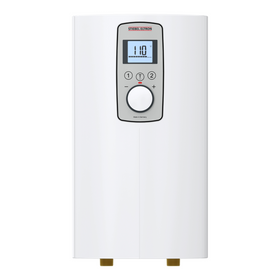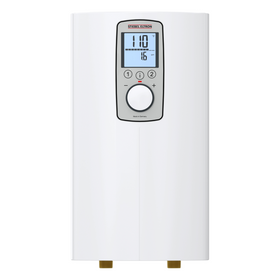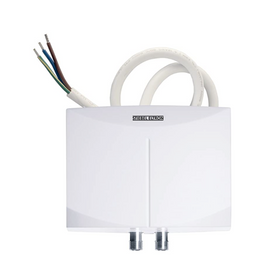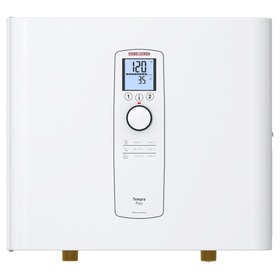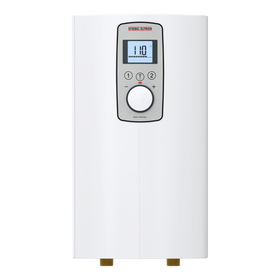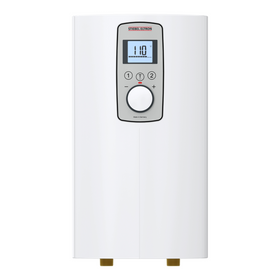
LEED for Homes 101: Water Efficiency
Last Updated: Apr 13, 2025As part of my LEED for Homes From the Editor series, I have introduced LEED for Homes 101 and provided an in-depth guide on the first two out of eight LEED categories, why Location & Transportation and Sustainable Sites matter. The third LEED category, Water Efficiency, is all about making more sustainable choices for indoor and outdoor water usage—which means saving water, a precious resource, and saving money on your water bills.
I should note that in April of this year (2019), the US Green Building Council announced a newer, updated version of LEED, version 4.1—and there are indeed changes. Going forward, I’ll be including the newer updates, but since it was just released, not all information is available—and in that case, I’ll look to LEED v4 as a resource. (If you are actually pursuing LEED, be sure and check with a LEED for Homes Provider.)
Why We Care About Water Efficiency
At home, we rely on freshwater for everything: washing dishes, washing clothes, bathing, brushing teeth, cleaning, cooking, flushing toilets, irrigating outdoor lawns, and plants. (This section does not include drinking water, which is more about health and less about efficiency.)
In the United States, according to a report from the U.S. Geological Survey(USGS), approximately 322 billion gallons of freshwater is withdrawn per day from rivers and reservoirs to support residential, commercial, industrial, agricultural, and recreational activities.
Table of Contents
- Measure your water
- Reduce Your Total Water Consumption
- Does This Cost More?

The residential component of total water use is fairly small: less than 10 percent. According to the Water Research Foundation’s 2016 report on Residential End Uses of Water, homes use an average of 88,000 gallons of water per year per household, and this has decreased by 22 percent since 1999 (the last time it was studied), due to more efficient toilets and clothes washers. But that trend needs to continue as our population grows and we consume more of our freshwater resources.
There are clear financial benefits to homeowners: water costs money, so why not try to be more efficient with it and save money every month? And it’s not just the water bill that can be reduced. Heating water for showers, dishes, and laundry take a lot of energy—about 10 to 15 percent of a home’s total energy use. So saving hot water also reduces your energy bill.
How do we save water in our homes without sacrificing comfort and convenience, and without spending too much on upfront costs? Here’s the translation of the Water Efficiency section of LEED v4.1 for Homes.
Measure your water
Take a look at your water bill. Does it make sense to you? Are you able to know how much water you are using in real-time, or do you have to wait a month or more for the water bill to show up? As with many sustainability measures, awareness is the first step, so LEED requires homes to install whole-house water meters. Compared to earlier versions of LEED for Homes, this is a new prerequisite. (Homes that use a well or are not connected to a municipally supplied water system are exempt. For multifamily housing, each unit needs to have its own sub-meter.)
Why is this important? As the Alliance for Water Efficiency explains, “installing meters and billing according to usage is the single most effective water conservation measure a water utility can initiate.” It’s the old adage, “what gets measured gets managed.”
Many building codes require that water meters be installed for new construction, so check with your contractor. Whether required or not, it’s not free. According to the Alliance for Water Efficiency, a residential-size water meter is about $40, and the cost to install one can range between $180 and $800+ per meter.
Reduce Your Total Water Consumption
Another new prerequisite requires that you reduce your indoor and outdoor water consumption by 20% compared to standard practices; anything over 20% can earn you up to 15 points. The two components to get there are indoor water usage (worth up to 11 points), and outdoor water usage (worth up to 4 points).
To start, you have a choice of two paths: a complicated, formulaic-driven path, or an easier-to-understand path where you pick your appropriate fixtures. The formulaic path allows the full 15 points if you reduce your indoor and outdoor water consumption by at least 80 percent compared to “standard practices”. You earn three points for a 20 percent reduction (meeting the prerequisite), and the points increase by one for each 5 percent reduction. Below, we look at ways to reduce both indoor and outdoor water consumption.

Indoor Water Consumption
If you are taking the formulaic path, how do you know where you land compared to standard practices? Federal (US) standard rates for all water-consuming appliances and fixtures were set by the US Energy Policy Act of 1992 and are as follows:
- Showers: 2.5 gallons per minute (gpm) or 9.5 liters per minute (lpm)
- Faucets: 2.2 gpm or 8.3 lpm
- Toilets: 1.6 gallons per flush (gpf) or 6 liters per flush (lpf)
- Clothes Washer: 9.5 water factor (WF)
- Dishwasher: 6.5 gallons per cycle (gpc) or 24 liters per cycle (gpc)
So, you need to choose fixtures and appliances that use less water than the standard—which is not that difficult, especially if you live in states like California, Washington, Nevada, Texas, Colorado, Georgia, Connecticut or New York, which have more stringent plumbing standards compared to national standards. You then have to calculate your estimated usage by using consumption assumptions about each appliance and fixture. If you like doing math and are pursuing the full 15 LEED points, here are the per person, per day usage assumptions:
- Shower: 6.15 minutes
- Faucet: 5 minutes
- Toilet: 5.05 flushes
- Clothes Washer: 037 cycles per 3.5 cubic feet
- Dishwasher: 0.1 cycles
Calculate your total usage compared to standard, and make sure your usage is at least 20 percent less. Because you are taking the average of all water usage, this method does allow you to go higher on some fixtures and lower on others.
But there’s a simpler path. If you are building new or remodeling, ask your contractor to find all WaterSense labeled fixtures, with the following specifications, listed in order of largest impact to smallest, based on average usage:
- Toilets: Choose a maximum average flush rate of 1.1 gallons per flush for one point. Dual flush toilets are also a viable option, but depending on the model, it may or may not give you a LEED point in version 4.1 of the rating system.
- Showerheads: Choose a maximum flow rate of 1.75 gpm for one point or 1.5 gpm for two points.
- Faucets: Choose a maximum flow rate of 1.5 gpm for one point, or 1.0 gpm for two points.
- Clothes Washers: Choose an ENERGY STAR labeled clothes washer, which can save you about 20 percent on the water used for washing, and make sure that the WF (water factor) is less than 9.5.
- Dishwashers: Choose an ENERGY STAR labeled dishwasher, which can save you $431 per year in energy and water compared to washing dishes by hand. All of these types of dishwashers use less than 3.5 gallons per cycle, far exceeding the maximum standard.
Water Pressure
The second component of Indoor Water Use is to make sure the water pressure in the house does not “exceed 60 pounds per square inch (414 kPa), with no detectable water leaks.” Water pressure that is too high (or any water leakage), will obviously be counter-productive to water conservation goals.
How do you know your water pressure? If you are connected to a municipally supplied water source, your local water provider can give you a reading (call them first to make sure they won’t charge you for it). You can also do it yourself by purchasing a water pressure gauge—usually $10 or less—from any hardware store. This video is helpful for the DIY-er: How to Check Your Home’s Water Pressure.
Outdoor Water Consumption
If you are taking the formulaic path, it requires you to “use the EPA WaterSense Water Budget Tool to calculate the baseline landscape water consumption and the design landscape water consumption.” This tool is not particularly user friendly; even landscape architects might struggle with it. Instead, here are some specific strategies to use to reduce outdoor water usage, divided into three sections.
1. What you plant (not grass)
The first strategy is to consider what you plant—such as a water-smart landscape—and how much water those plants will need. This LEED credit calls out specific requirements when it comes to lawns: you can earn one point if you reduce your turfgrass by 25 percent as a percentage of the total landscape area and install native and adaptive plantings instead. The full 4 points can be earned if your turfgrass is less than 5 percent of the total landscape area and native and adaptive plants cover more than 75 percent of your landscape area. Why? Lawns are not LEED-friendly, as they require water, fertilizer, and gas-guzzling lawnmowers. As a mono-species, they do very little for habitat, particularly when compared to pollinator gardens—which also require much less maintenance than turfgrass.
2. Where you get your water for irrigation
Then, if you still need some sort of irrigation for plants, trees, or turf, look at ways to reduce your reliance on your water supply. Strategies include using reclaimed water (like greywater) and/or captured rainwater.
3. How you irrigate
Finally, if you still rely on municipally supplied water and are installing an irrigation system, consider the following recommendations (taken verbatim from this LEED credit):
- Use of pressure regulation for every zone (valve or sprinkler)
- Use of check valves on sloped irrigation zones, where needed to prevent low head drainage
- Flow sensing with a master valve and irrigation controller that responds to a high-flow occurrence
- Use of smart irrigation control technology (weather-based, soil moisture sensors, rain sensors, etc.)
- Create separate zones for each type of bedding area based on watering needs
- Use of drip irrigation for at least 50% of planting area
Does This Cost More?
In addition to a small incremental cost for a water meter, the process of LEED certification can add some cost—specifically, having the Green Rater come to inspect the house at different stages. For plumbing fixtures and landscaping, this can be completed at the end of construction. But it can be helpful for the Green Rater to do so earlier, so if anything is wrong, it is caught while it is still easy to swap out a fixture. It is also a great quality assurance measure to ensure your home is being built to requested specifications. The cost of a Green Rater is variable, depending on your local provider and how many tests he/she conducts. For us, ten years ago, the total cost was $1,800 for all of the tests; the plumbing verification was a very small part of it.
The bottom line is that complying with these requirements—which you can do whether or not you are pursuing LEED certification—should not cost more. Price differentials are based more on the selection of materials and brands. But you will save money on your water and energy bills, year after year. And, because of advances in faucet design, it is extremely difficult to tell the difference when you use these low-flow and low-flush fixtures—so you will not be sacrificing comfort.
Next up? The largest LEED for Homes category: Energy & Atmosphere, worth a total of 38 points. Over the next three months, we’ll take a look at best practices in home energy efficiency and renewable energy.
Melissa Rappaport Schifman
Melissa became the Twin Cities’ fifth LEED for Homes Accredited Professional (LEED AP) and completed the work necessary to get her own home LEED Gold Certified, the basis for her book, Building a Sustainable Home: Practical Green Design Choices for Your Health, Wealth, and Soul, (Skyhorse Publishing, August, 2018). With her corporate experience in finance, marketing, and business development, and an MBA and Master’s in Public Policy from the University of Chicago, Melissa has been providing sustainability advisory services to businesses, governmental agencies and non-profits, focusing on strategic and operational change that provide bottom-line financial returns. She has led the LEED certification of two million square feet of commercial buildings, written GRI-compliant Corporate Sustainability Reports, is a LEED Pro Reviewer and LEED mentor with the U.S. Green Building Council. She is the founder of Green Intention LLC where she writes about sustainable home living.




